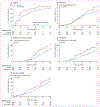Morbidity and mortality after lifestyle intervention for people with impaired glucose tolerance: 30-year results of the Da Qing Diabetes Prevention Outcome Study
- PMID: 31036503
- PMCID: PMC8172050
- DOI: 10.1016/S2213-8587(19)30093-2
Morbidity and mortality after lifestyle intervention for people with impaired glucose tolerance: 30-year results of the Da Qing Diabetes Prevention Outcome Study
Abstract
Background: Lifestyle interventions can delay the onset of type 2 diabetes in people with impaired glucose tolerance, but whether this leads subsequently to fewer complications or to increased longevity is uncertain. We aimed to assess the long-term effects of lifestyle interventions in people with impaired glucose tolerance on the incidence of diabetes, its complications, and mortality.
Methods: The original study was a cluster randomised trial, started in 1986, in which 33 clinics in Da Qing, China, were randomly assigned to either be a control clinic or provide one of three interventions (diet, exercise, or diet plus exercise) for 6 years for 577 adults with impaired glucose tolerance who usually receive their medical care from the clinics. Subsequently, participants were followed for up to 30 years to assess the effects of intervention on the incidence of diabetes, cardiovascular disease events, composite microvascular complications, cardiovascular disease death, all-cause mortality, and life expectancy.
Findings: Of the 577 participants, 438 were assigned to an intervention group and 138 to the control group (one refused baseline examination). After 30 years of follow-up, 540 (94%) of 576 participants were assessed for outcomes (135 in the control group, 405 in the intervention group). During the 30-year follow-up, compared with control, the combined intervention group had a median delay in diabetes onset of 3·96 years (95% CI 1·25 to 6·67; p=0·0042), fewer cardiovascular disease events (hazard ratio 0·74, 95% CI 0·59-0·92; p=0·0060), a lower incidence of microvascular complications (0·65, 0·45-0·95; p=0·025), fewer cardiovascular disease deaths (0·67, 0·48-0·94; p=0·022), fewer all-cause deaths (0·74, 0·61-0·89; p=0·0015), and an average increase in life expectancy of 1·44 years (95% CI 0·20-2·68; p=0·023).
Interpretation: Lifestyle intervention in people with impaired glucose tolerance delayed the onset of type 2 diabetes and reduced the incidence of cardiovascular events, microvascular complications, and cardiovascular and all-cause mortality, and increased life expectancy. These findings provide strong justification to continue to implement and expand the use of such interventions to curb the global epidemic of type 2 diabetes and its consequences.
Funding: US Centers for Disease Control and Prevention, WHO, Chinese Center for Disease Control and Prevention, World Bank, Ministry of Public Health of the People's Republic of China, Da Qing First Hospital, China-Japan Friendship Hospital, and National Center for Cardiovascular Diseases & Fuwai Hospital.
Copyright © 2019 Elsevier Ltd. All rights reserved.
Conflict of interest statement
Declaration of interests
We declare no competing interests.
Figures



Comment in
-
Da Qing 30 years on: more reasons to extend diabetes prevention.Lancet Diabetes Endocrinol. 2019 Jun;7(6):417-419. doi: 10.1016/S2213-8587(19)30138-X. Epub 2019 Apr 25. Lancet Diabetes Endocrinol. 2019. PMID: 31031111 No abstract available.
-
Prevention begets prevention - lessons from the Da Qing Study.Nat Rev Endocrinol. 2019 Aug;15(8):442-443. doi: 10.1038/s41574-019-0227-1. Nat Rev Endocrinol. 2019. PMID: 31197267 No abstract available.
-
Lifestyle intervention and impaired glucose tolerance in the Da Qing study.Lancet Diabetes Endocrinol. 2019 Sep;7(9):669-670. doi: 10.1016/S2213-8587(19)30261-X. Lancet Diabetes Endocrinol. 2019. PMID: 31439273 No abstract available.
-
Lifestyle intervention and impaired glucose tolerance in the Da Qing study - Authors' reply.Lancet Diabetes Endocrinol. 2019 Sep;7(9):670. doi: 10.1016/S2213-8587(19)30262-1. Lancet Diabetes Endocrinol. 2019. PMID: 31439275 No abstract available.
-
Good news from the Da Qing Diabetes Prevention Outcome Study-healthy lifestyles result in long-term cardiovascular benefits.Ann Transl Med. 2019 Dec;7(Suppl 8):S368. doi: 10.21037/atm.2019.08.123. Ann Transl Med. 2019. PMID: 32016086 Free PMC article. No abstract available.
References
-
- International Diabetes Federation. IDF diabetes atlas, 8th edn. Brussels: International Diabetes Federation, 2017.
-
- Gregg EW, Cheng YJ, Srinivasan M, et al. Trends in cause-specific mortality among adults with and without diagnosed diabetes in the USA: an epidemiological analysis of linked national survey and vital statistics data. Lancet 2018; 391: 2430–40. - PubMed
-
- Bennett PH, Knowler WC, Pettitt DJ, Carraher MJ, Vasquez B. Longitudinal studies of the development of diabetes in the Pima Indians. In: Eschwege E, ed. Advances in diabetes epidemiology. Amsterdam: Elsevier Biomedical Press, 1982: 65–74.
-
- Pan XR, Li GW, Hu YH, et al. Effects of diet and exercise in preventing NIDDM in people with impaired glucose tolerance: the Da Qing IGT and Diabetes study. Diabetes Care 1997; 20: 537–44. - PubMed

